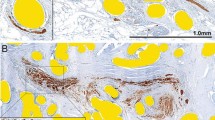Summary
The age distribution for presentation of 64 inguinal hernias in children had a biphasic distribution with cases initially occurring from birth to 4 months, then a lag and thereafter the incidence rose after 1 year of age. Males constituted 51/64 of the cases. A neuropeptide, calcitonin gene related peptide (CGRP), that is present in the genitofemoral nerve (GFN) which innervates the processus vaginalis was found to induce fusion of the hernial sac tissue. In vitro organ cultures of human processus vaginalis were used to assay for hernial fusion and to study the morphological changes associated with this process. The processus vaginalis was folded so that the surfaces lining the sac were lying next to each other. The length of fused surface along this fold line was assayed by microscopy and quantitated for each specimen that fulfilled the criteria of healthy intact tissue. The average length of fusion for children ≤ 4 months of age was 67.7% for CGRP with a background of 49.4% fusion when tissue was incubated with phosphate buffered saline (PBS) addition to the medium. In children over 4 months the degree of fusion was less with 31.7% and 23.3% for CGRP and PBS, respectively. The mean difference between CGRP and PBS groups was 17.5% for children ≤ 4 months and 4.5% for older children with the difference being significantly different (p=0.0018) for the younger group only. The morphological changes of the fused processus vaginalis tissue resembled transformation from an epithelial to mesenchymal cell type. The cells lining the processus vaginalis expressed cytokeratin and appeared to be a differentiated epithelial cell type. Transformation of this type is a common mechanism of tissue remodelling in embryological development. A growth factor often associated with such embryological changes is hepatocyte growth factor/scatter factor (HGF/SF) and this factor was also found to induce fusion of the processus vaginalis. In hernial tissue from children of ≤ 4 months of age HGF/SF induced a significant degree of fusion (p=0.038) as it did in older cases (p=0.015). This in vitro model approach to the understanding of inguinal hernia closure could lead to a nonsurgical treatment of this condition.
Similar content being viewed by others
References
Atwell (1962) Inguinal hernia in female infants and children. Br J Surg 50: 294–297
Backhouse KM, Butler H (1960) The gubernaculum testis of the pig (sus scropha). J Anat 94: 107–121
Beasley SW, Hutson JM (1987) Effect of division of the genitofemoral nerve on testicular descent in the rat. Aust NZ J Surgery 57: 49–51
Boyer B, Thiery JP (1993) Epithelium-mesenchyme interconversion as example of epithelial plasticity. APMIS 101: 257–268
Campbell JR (1989) Inguinal and scrotal problems in infants and children. Pediatric Ann 18: 189–191
Fitchett JE, Hay ED (1989) Medial edge epithelium transforms to mesenchyme after embryonic palatal shelves fuse. Developmental Biol 131: 455–474
Franke WW, Schmid E, Schiller DL, Winter S, Jarasch ED, Mou R, Denk H, Jackson BW, Illmensee K (1982) Differentiation related patterns of expression of proteins of intermediate filaments in tissues and cultured cells. Cold Spring Harbour Symposia Quantitative Biology 46: 431–435
Hay ED (1995) An overview of epithelio-mesenchy-mal transformation. Acta Anatomica 154: 8–20
Herzog B, Steigert M, Hadziselimovic F (1992) Is a testis located at the superficial inguinal pouch (Denis Browne pouch) comparable to a true cryptorchid testis. J Urol 148: 622–623
Hutson JM, Albano FR, Paxton G, Sugita Y, Connor R, Clarnette TD, Gray AZ, Watts LM, Farmer PJ, Hasthorpe S (1999) In vitro fusion of human inguinal hernia with associated epithelial transformation. Cells Tissues Organs (in press)
Hutson JM, Hasthorpe S, Heyns CF (1997) Anatomical and functional aspects of testicular descent and cryptorchidism. Endocrine Reviews 18: 259–280
Johansen TEB (1988) The anatomy of the gubernaculum testis and processus vaginalis in cryptorchid. Scand J Urol Nephrol 22: 101–105
Larkins SL, Hutson JM (1991) Fluorescent anterograde labelling of the genitofemoral nerve shows that it supplies the scrotal region before migration of the gubernaculum. Pediatric Surgery Int 6: 167–171
Mitchell GAG (1939) The condition of the peritoneal processus at birth. B J Anat 73: 658–661
Momoh JT (1985) External hernia in Nigerian children. Annals of Tropical Paediatrics 5: 197–200
Schwindt B, Farmer PJ, Watts LM, Hrabovszky Z, Hutson JM (1999) Localisation of calcitonin gene related peptide (CGRP) within the genitofemoral nerve (GFN) in immature rats. J Pediatric Surgery 34: 986–991
Scorer CG, Farrington GH (1971) Congenital deformities of testis and epididymis. Butterworths, London
Sonnenberg E, Meyer D, Weidner M, Birchmeier C (1993) Scatter factor/hepatocyte factor and its receptor the c-met tyrosine kinase, can mediate a signal exchange between mesenchyme and epithelia during mouse development. J Cell Biol 123: 223–235
Tayakkanonta K (1963) The gubernaculum testis and its nerve supply. Aust NZ J Surgery 33: 61–67
Watabe M, Nagafuchi A, Tsukita M, Takeichi M (1994) Induction of polarized cell-cell association and retardation of growth by activation of the E-cadherin-catenin adhesion system in a dispersed carcinoma line. J Cell Biol 127: 247–256
Author information
Authors and Affiliations
Additional information
Supported by National Health & Medical Research Council, Grant Number 980670
Rights and permissions
About this article
Cite this article
Paxton, G., Hutson, J.M. & Hasthorpe, S. Age distribution of inguinal hernia fusionin vitro . Hernia 3, 175–180 (1999). https://doi.org/10.1007/BF01194421
Received:
Accepted:
Issue Date:
DOI: https://doi.org/10.1007/BF01194421




